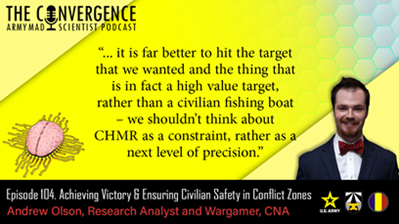“… it is far better to hit the target that we wanted and the thing that is in fact a high value target rather than a civilian fishing boat – we shouldn’t think about CHMR as a constraint, rather as a next level of precision.”
[Editor’s Note: Army Mad Scientist first introduced Andrew Olson to our community of action with his insightful submission to our Calling All Wargamers crowdsourcing effort entitled Civilian Harm Mitigation and Response (CHMR) Considerations in Wargaming LSCO. In today’s episode of The Convergence podcast, we sit down with Mr. Olson to learn more about CHMR — now a DoD priority with the implementation of DoDI 3000.17 on 21 December 2023 — and how incorporating it into the Army’s wargaming activities can help our Leaders understand how it “supports U.S. national security interests… furthering strategic objectives to achieve long-term strategic success, enhancing the effectiveness and legitimacy of military operations, and demonstrating moral leadership.” CHMR helps ensure we retain the moral high ground when executing military operations, are more precise with our application of lethal force, and are more effective at the operational level — all essential components of achieving victory — Enjoy!]
[If the podcast dashboard above is not rendering correctly for you, please click here to listen to the podcast.]
Andrew Olson is an Associate Research Analyst at CNA, specializing in wargaming. He has experience with a variety of educational and analytical approaches, with a particular interest in wargaming policy challenges, climate change wargames, and emerging technologies wargames. He has facilitated wargames for the National Academies, U.S. Marine Corps, U.S. Navy, Pew Charitable Trusts, U.S. State Department, and the Joint Staff, among others. Prior to joining CNA, Mr. Olson worked for the Department of State examining technology cooperation challenges. He has managed several print publications, including the Science and Technology section of the Georgetown Journal of International Affairs, and served as lead researcher and lab manager for a biological research lab examining the genetic foundations of empathy. Mr. Olson holds a Master of Science in foreign service from Georgetown University and Bachelor of Arts degrees in biology and political science from Westmont College in Santa Barbara, California.
an Associate Research Analyst at CNA, specializing in wargaming. He has experience with a variety of educational and analytical approaches, with a particular interest in wargaming policy challenges, climate change wargames, and emerging technologies wargames. He has facilitated wargames for the National Academies, U.S. Marine Corps, U.S. Navy, Pew Charitable Trusts, U.S. State Department, and the Joint Staff, among others. Prior to joining CNA, Mr. Olson worked for the Department of State examining technology cooperation challenges. He has managed several print publications, including the Science and Technology section of the Georgetown Journal of International Affairs, and served as lead researcher and lab manager for a biological research lab examining the genetic foundations of empathy. Mr. Olson holds a Master of Science in foreign service from Georgetown University and Bachelor of Arts degrees in biology and political science from Westmont College in Santa Barbara, California.
Army Mad Scientist sat down with Andrew Olson to discuss CHMR, its evolution within wargames, and its impact on Army planning. The following bullet points highlight key takeaways from our conversation:
-
-
- Civilian Harm Mitigation and Response (CHMR) is not a constraint – it is how we win. Effective CHMR is a part of how the U.S. can achieve its strategic and operational outcomes. Wargaming provides Leaders with the opportunity of exploring unfamiliar scenarios in a fail-safe environment. Future conflicts are likely to include the
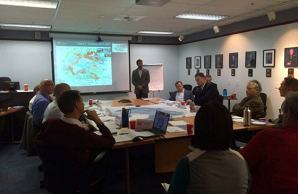 possibility of civilian harm – integrating CHMR into wargaming is essential in allowing our decision-makers the space to understand the full consequences of their decisions and actions.
possibility of civilian harm – integrating CHMR into wargaming is essential in allowing our decision-makers the space to understand the full consequences of their decisions and actions.
- Civilian Harm Mitigation and Response (CHMR) is not a constraint – it is how we win. Effective CHMR is a part of how the U.S. can achieve its strategic and operational outcomes. Wargaming provides Leaders with the opportunity of exploring unfamiliar scenarios in a fail-safe environment. Future conflicts are likely to include the
-
-
-
- CHMR is not a single inject to tack on at the end of a wargame – it must be a consistent approach that is incorporated into the development of commanders’ guidance, mission planning, courses of
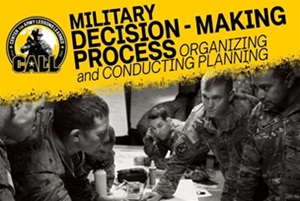 action, and targeting plans. Diffusing CHMR throughout every step of a wargame forces every player to account for civilian harm in decision-making at all levels and steps of mission planning and execution. The importance does not fall on CHMR simply being injected into every step of a wargame, but in making informed decisions towards a strategic outcome, of which CHMR is a part.
action, and targeting plans. Diffusing CHMR throughout every step of a wargame forces every player to account for civilian harm in decision-making at all levels and steps of mission planning and execution. The importance does not fall on CHMR simply being injected into every step of a wargame, but in making informed decisions towards a strategic outcome, of which CHMR is a part.
- CHMR is not a single inject to tack on at the end of a wargame – it must be a consistent approach that is incorporated into the development of commanders’ guidance, mission planning, courses of
-
-
-
- The wargaming community is currently grappling with a form of “systems thinking” – how to deal with cascading effects, how to
 think about interconnected digital and electrical environments, and how to understand the information environment. Unintended consequences resulting in civilian harm are possible due to the interconnectedness of many “systems.”
think about interconnected digital and electrical environments, and how to understand the information environment. Unintended consequences resulting in civilian harm are possible due to the interconnectedness of many “systems.”
- The wargaming community is currently grappling with a form of “systems thinking” – how to deal with cascading effects, how to
-
-
-
- Challenges presented in Large-Scale Combat Operations (LSCO) — communications disruptions, volume and speed of targets, logistics, and distance — all play into CHMR, making it a critical aspect of
 operations. Although CHMR must be a priority regardless of adversary actions or thinking, adversaries in LSCO are likely to exploit instances of civilian harm and the associated disinformation opportunities that arise.
operations. Although CHMR must be a priority regardless of adversary actions or thinking, adversaries in LSCO are likely to exploit instances of civilian harm and the associated disinformation opportunities that arise.
- Challenges presented in Large-Scale Combat Operations (LSCO) — communications disruptions, volume and speed of targets, logistics, and distance — all play into CHMR, making it a critical aspect of
-
-
-
- CHMR doesn’t prevent us from taking military actions — it means we consider the risks to civilians that exist and work to mitigate them where possible. That is a part of our theory of victory and additionally
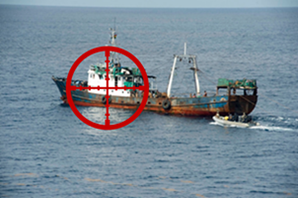 helps us become more effective on the operational level. “It is far better to hit the target that we wanted and the thing that is in fact a high value target, rather than a civilian fishing boat – we shouldn’t think about CHMR as a constraint, rather as a next level of precision.“
helps us become more effective on the operational level. “It is far better to hit the target that we wanted and the thing that is in fact a high value target, rather than a civilian fishing boat – we shouldn’t think about CHMR as a constraint, rather as a next level of precision.“
- CHMR doesn’t prevent us from taking military actions — it means we consider the risks to civilians that exist and work to mitigate them where possible. That is a part of our theory of victory and additionally
-

Stay tuned to the Mad Scientist Laboratory for our next episode of The Convergence, when we sit down with Sebastian Bae, Senior Game Designer at CNA’s Gaming Program and wargame design instructor at Georgetown University’s Security Studies Program, to discuss how wargaming can help prepare our Leaders for a complex Operational Environment.
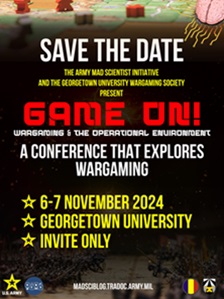 Army Mad Scientist and the Georgetown University Wargaming Society want to invite you to our Game On! Wargaming & The Operational Environment Conference.
Army Mad Scientist and the Georgetown University Wargaming Society want to invite you to our Game On! Wargaming & The Operational Environment Conference.
What: An in-person conference to explore Wargaming and how it can help the Army better understand the Operational Environment
When: 6-7 November 2024
Where: The Healey Family Student Center, Georgetown University, 3700 Tondorf Road, Washington, DC 20057
Why: To explore new wargaming methods, new ways to incorporate learning into Professional Military Education, and have an open dialogue with wargamers inside and outside the military.
***In order to attend, you must register through Eventbrite — click here now to reserve your seat — access will be limited to registered attendees only!***
Stay tuned to the Mad Scientist Laboratory for conference updates and forward any questions you may have to madscitradoc@gmail.com
In the meantime, check out Andrew Olson‘s submission to our Calling All Wargamers crowdsourcing effort — Civilian Harm Mitigation and Response (CHMR) Considerations in Wargaming LSCO — as well as the following Mad Scientist Laboratory wargaming related content:
Brian Train on Wargaming Irregular and Urban Combat
Live from D.C., it’s Fight Night (Parts One and Two) and associated podcasts (Parts One and Two)
Would You Like to Play a Game? Wargaming as a Learning Experience and Key Assumptions Check and “No Option is Excluded” — Using Wargaming to Envision a Chinese Assault on Taiwan, by Ian Sullivan
Using Wargames to Reconceptualize Military Power, by proclaimed Mad Scientist Caroline Duckworth
Gaming the System: How Wargames Shape our Future and associated podcast, with guest panelists Ian Sullivan, Mitchell Land, LTC Peter Soendergaard, Jennifer McArdle, Becca Wasser, Dr. Stacie Pettyjohn, Sebastian Bae, Dan Mahoney, and Jeff Hodges
The Storm After the Flood virtual wargame scenario, video, notes, and Lessons Learned presentation and video, presented by proclaimed Mad Scientists Dr. Gary Ackerman and Doug Clifford, The Center for Advanced Red Teaming, University at Albany, SUNY
Gamers Building the Future Force and associated podcast
Disclaimer: The views expressed in this blog post do not necessarily reflect those of the U.S. Department of Defense, Department of the Army, Army Futures Command (AFC), or Training and Doctrine Command (TRADOC).

